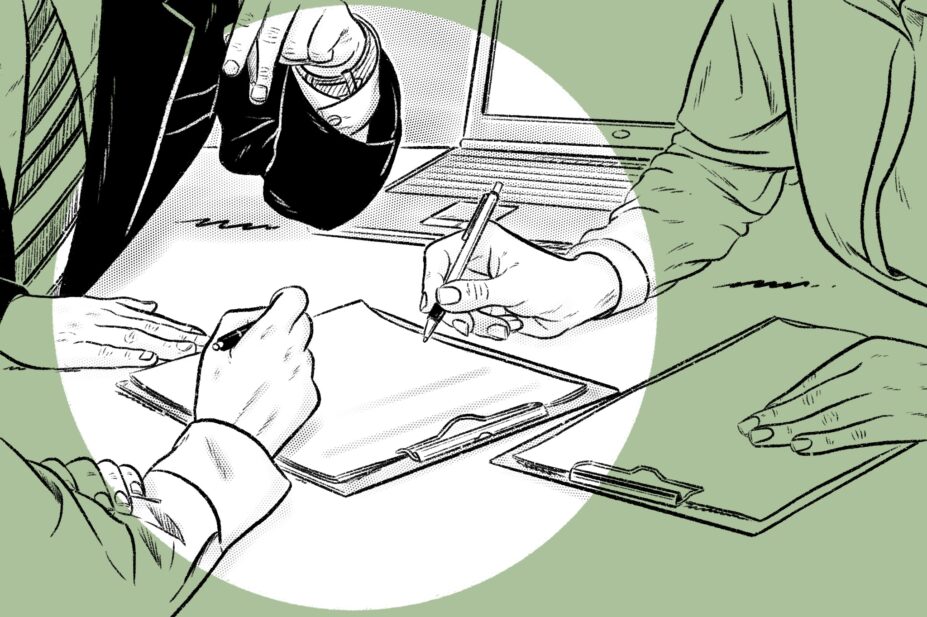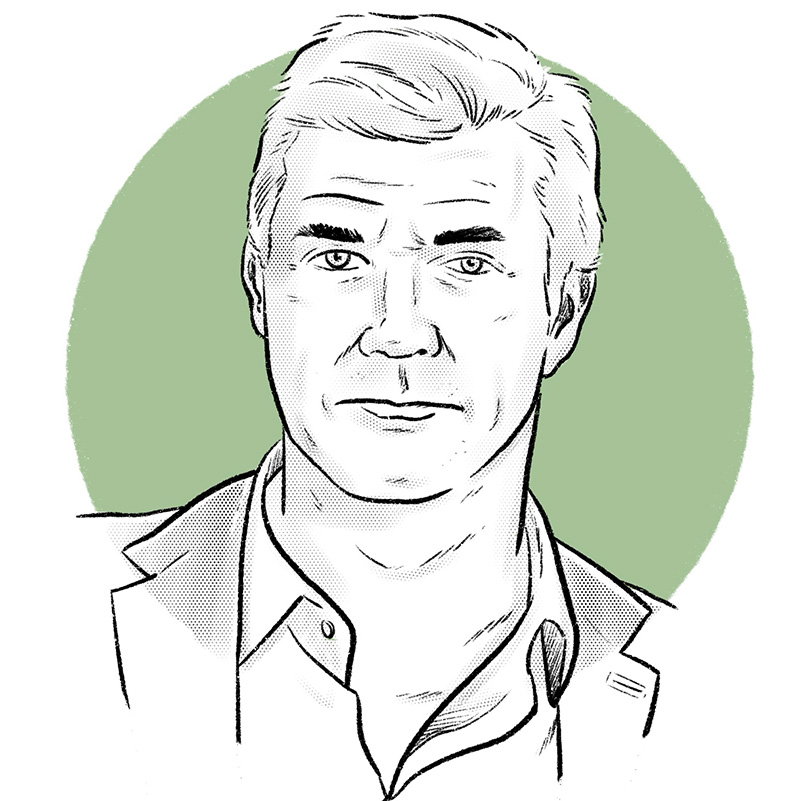
Wes Mountain/The Pharmaceutical Journal
By the end of this article, you will be able to:
- Recognise the value of reflective practice within prescribing and the different ways it can drive improvement and support patient safety;
- Describe the role of peer review in the context of your prescribing role;
- Identify how you can develop your own reflective practice to enhance your prescribing role.

RPS Competency Framework for All Prescribers
This article aims to support the development of knowledge and skills related to the following competencies:
Domain 8: Prescribe Professionally (8.1)
- Ensures confidence and competence to prescribe are maintained.
Domain 9: Improve prescribing practice (9.1, 9.3, 9.4, 9.5, 9.6)
- Improves by reflecting on own and others’ prescribing practice, and by acting upon feedback and discussion;
- Understands and uses available tools to improve prescribing practice;
- Takes responsibility for own learning and continuing professional development relevant to the prescribing role;
- Makes use of networks for support and learning;
- Encourages and supports others with their prescribing practice and continuing professional development.
Introduction
Reflection is a natural activity that we all undertake to some degree in both our professional and personal lives, often subconsciously.
The benefits of reflection to individual practitioners, patients and the health system are widely recognised and all healthcare professionals, including pharmacist prescribers, are advised to incorporate reflection into their routine practice.
This has been defined in a joint statement by the chief executives of statutory regulators of health and care professionals published in 20191. Most independent prescribing courses include a reflective portfolio as part of the assessment criteria, supporting your learning as you develop and implement new or enhanced knowledge and skills during the programme2. Annual revalidation with the General Pharmaceutical Council (GPhC) also includes a requirement for reflective activity3. This is in the context of both planned and unplanned learning but also in relation to individual compliance and demonstration of the GPhC standards.
Both experienced pharmacist prescribers and those who are new to prescribing will find benefit in reflection to help them consolidate knowledge, develop new insights and work more efficiently. Reflection can be used by prescribers in multiple ways — it can support development and implementation of service improvement; it can enhance your ability to learn from near misses, review and improve patient safety; and is a powerful tool that supports personal and professional growth, including expanding scope of practice. The benefits of reflection are wide ranging and can help improve patient care and create more effective interactions with the wider clinical team.
This article will explore how refection can enhance prescribing practice. While many of us will reflect on prior activities, with practice and experience, pharmacy professionals will be able to incorporate proactive reflection within patient consultations, which will provide more responsive patient care.
It is recommended that this article is read in conjunction with these resources from The Pharmaceutical Journal:
- ‘Practising reflection in pharmacy‘;
- ‘Revalidation: how to complete your reflective account‘;
- ‘Revalidation: how to use planned and unplanned learning entries to record CPD‘.
To help further expand your prescribing skills, additional related articles are linked throughout. There is an opportunity to test your knowledge by completing a short quiz at the end of the article.
Why reflect as a pharmacist prescriber?
While pharmacists have been able to train as prescribers for almost 20 years, the profession is currently in the middle of a rapid expansion in the number of pharmacists annotated as independent prescribers by the GPhC4. Changes to legislation have been made that will allow newly registered pharmacists to operate as prescribers from the point of registration for those who graduate from 2026 onwards marking a fundamental shift in the way the profession works5.
As a pharmacist prescriber, with more clinical autonomy and additional accountabilities comes increased responsibility for identifying safe and appropriate clinical treatment options and achieving shared decision-making in discussion with patients. This changed professional context requires the development of new skills, which will stretch and challenge the workforce. Assessment and diagnostic skills, alongside consultation skills, need to be enhanced and prescribers will need to become comfortable dealing with complexity and managing uncertainty. It will take time and practice for these skills to become routine and will remain an ongoing area of development for prescribers after gaining a formal qualification.
Box 1 illustrates a simple way that reflection can be used as a tool for self-assessing your level of competence, potentially identifying areas where development may be required or helping you to make a judgement about your scope of practice. As an independent prescriber, it is anticipated that you will have demonstrated competency in an initial therapeutic area during your time as an ‘independent prescriber in training’6. Legislation does allow pharmacist independent prescribers to prescribe any medication if competent to do so and pharmacy professionals need to be able to justify individual prescribing decisions. Reflection can enable pharmacists to use the practice experiences gained each day to identify areas for continuous professional development7.
Box 1: Reflection in practice — developing new skills
Take a moment to consider how your confidence and skill in a particular aspect of your life has changed over time. For example, if you are a car driver, think how your competence has changed since the first time you operated a vehicle, through passing your driving test and as you began to drive independently without direct supervision.
Think also about whether you have developed bad habits in the way that you apply this or any other skill.
Now think about your role as a pharmacist. Are there any skills that have similarly become automatic over time? What did it take for this to happen?
Individual reflection
All of us subconsciously reflect, often on difficult interactions or conversations that we wished had gone differently. This could manifest, as playing events of the day over in one’s mind on the journey home from work or talking things through with a friend or family member. In the context of prescribing, reflection can work in a very similar way. One may think about a particular consultation or wonder if there may have been a better way of working through a situation.
It is equally important to reflect on events or interactions that have gone well; it supports analysis of how or if a positive contribution to patient care could be further built on or whether there is potential to share learning and influence a wider change in practice within one’s team or workplace.
How we reflect is influenced by our own personal learning style that has been explained in detail within pharmacy educational resources and publications8,9. You may prefer to discuss care of an individual patient with a colleague as a case-based discussion or as part of a multidisciplinary team meeting (MDT) to gain a consensus view on clinical practice. Alternatively, you may consider reflecting on new or updated knowledge gained from review of a guideline or published clinical evidence or by speaking to or listening to an established expert at a meeting, training event or webinar.
The way you discuss treatment options and medications may change within an individual consultation, based on the information gained from a patient as you work to deliver personalised care and shared decision making; this is also a form of reflection.
As with the previous metaphor relating to learning to drive, a skilled reflective practitioner will develop the ability to draw on reflective practice automatically and use it as a tool to enhance interpersonal effectiveness during patient encounters, a skill known as reflection in action (see Box 2).
Box 2: Focus in practice — Reflection on action versus reflection in action
Differing types of reflection described above could be defined simply as reflection on action, consideration of something that has already happened. Alternatively, reflection in action is proactively challenging your thought process and decision making within the consultation.
The more often you reflect on previous actions, the more your knowledge, skills and confidence to reflect in the moment will improve.
Structures for reflective practice
You may already be aware of several models used to support the development of reflective practice, such as Gibbs Cycle — a six-part process as described below10:
- Description: Describe the experience;
- Feelings: Reflect on your feelings and thoughts about the experience;
- Evaluation: Evaluate the experience, both good and bad;
- Analysis: Make sense of the situation;
- Conclusion: Consider what you learned and what you could have done differently;
- Action Plan: Develop a plan for future situations
Kolb’s Experiential Learning Cycle is a second widely used mode that you may also wish to explore or Driscoll’s ‘What Model’11,12. These three examples of reflective models are shown in the figure below.
Another reflective tool available to prescribers is the use of Balint Groups, which were first developed in the 1950s to support GPs to listen to patients and reflect on their practice. The structure typically included a case presentation followed by a general group discussion.
Balint groups have developed further to include other healthcare professions and the wider team, and are intended to provide a supportive environment to discuss individual patient interactions that provide learning opportunities or a means to improve patient safety or quality of care13. Useful information, including how to start a Balint group, can be found on the Balint Society website.
Finally, you could consider a guided reflection where an experienced colleague or mentor guides your reflection by use of questions14. This is an approach often used by designated prescribing practitioners.
It is important to consider how you choose to reflect and if you could take a different approach to reflection by challenging yourself and your thought processes. As individuals, if we always take the same approach or talk to colleagues with the same skillset or knowledge, we are reinforcing our own experience2.
Peer review
GPhC revalidation requirements include peer review to facilitate reflection on ways that you can improve and develop as a prescribing pharmacist. Peer review could be related to a single patient interaction (e.g. soliciting feedback from a colleague observing your consultation with a patient), establishing a new service or your individual personal development, which may include new knowledge gained from reading or attendance at a training event3.
Good practice guidance published by the GPhC advises how to prepare for a peer review as an individual but also when you are acting as a peer reviewer15.
Peer review can be a with another pharmacist or with a colleague with a different professional background. There is also evidence which supports the value of interprofessional peer review to consider healthcare from the perspective of a colleague with a complementary skillset to your own16,17.
There is value in patient questionnaires, 360-degree feedback from your peers or colleagues or auditing your own prescriptions to gain a holistic view of your prescribing practice and discussing the outcomes with trusted colleagues18,19.
Self-assessing your competency as a prescriber
When considering what constitutes a good prescriber there have been several studies20,21, several of which consider pharmacist prescribers specifically22. The ‘RPS Competency Framework for All Prescribers’ similarly provides a comprehensive description of what constitutes safe and effective prescribing and defines expectations for the UK healthcare professions23.
A documentary analysis of UK and international prescribing practice guidelines has further provided consideration of what makes a model prescriber across all parts of the multidisciplinary team and four aspects have been identified24.
Defined by Omar et al. as:
- Knowledgeable: including that of disease and of drug properties;
- Safe: relating to appropriate drug quantities and to treatment monitoring;
- Good communicators: with both patients and with colleagues;
- Contemporary: through enhancing knowledge and skills to keep up to date.
The following case study will explore how we can use reflection alongside clear descriptors of good practice to analyse typical patient interactions and identify possible alternative actions or approaches.
Case in practice
Assessing competence against the four characteristics of a model prescriber
A 50-year-old white male ‘Simon’ has been referred to you as a pharmacist prescriber with competency to prescribe in the management of hypertension, you feel confident about the treatment recommendations as published by the National Institute for Health and Care Excellence (NICE) for the management of hypertension25.

Simon had presented for a COVID-19 vaccination clinic and his blood pressure had been checked while awaiting vaccination; on that day the best reading was recorded as 160/95mmHg. On attending your clinic, he had undertaken seven days of home readings, which averaged as 155/90mmHg; however, no other tests or investigations had been undertaken.
Simon is a non-smoker and describes himself as quite active, with a body mass index (BMI) in normal range, he works in an office and walks to work daily (around two miles each way). On arriving at work, he enjoys a coffee and bacon sandwich and states he has a healthy diet. Currently he does not take any medicines apart from the occasional over-the-counter analgesic.
In discussion it was confirmed that Simon did not have any headaches, changes in vision, chest pain or shortness of breath but he did report a family history of hypertension. Simon was very anxious about his blood pressure and keen to start medication.
Simon was provided with advice about reducing both his salt and caffeine intake and the rationale for why this would have a positive impact on his blood pressure.
To allow for fuller assessment of any impact of raised blood pressure, Simon agreed to the following: referral to an optician (to check for retinopathy); to attend for blood tests to allow consideration of kidney function and any other factors that may impact on his cardiovascular health, such as raised cholesterol or glucose levels. Simon would provide an early morning urine sample (as part of assessment of nephropathy) and attend for a routine ECG to confirm there are no abnormalities in heart rhythm or impact on left ventricular function.
For a white patient aged under 55 years, NICE recommends an angiotensin-converting-enzyme (ACE) inhibitor as first line, but without baseline renal function it was not appropriate to start this medication26.
Considering Simon’s anxiety about his blood pressure and anticipating that more than one agent may be needed to reduce his blood pressure to the target level advised by NICE, it was agreed as a shared decision with Simon that a calcium channel blocker (amlodipine 5mg daily) would be started.
Reflect on this scenario using the four aspects of a model prescriber and record how you think the pharmacist prescriber has performed against them and what approach you would take in their place. Some questions are provided as prompts to guide your reflection.
Knowledgeable
Consider the possible treatment options available to Simon, including medication and non-pharmacological interventions, such as improvements to diet and increasing exercise.
How would the information and recommendations you provide be different if Simon was:
- A different ethnicity (e.g, Black African or South Asian);
- Aged under 40 years or over 80 years;
- A female patient;
- A patient with a BMI outside the healthy range.
How would you explain your rationale in each case for tailoring the treatment to the individual? What communication strategy would you use?
Safe
What signs or symptoms would prompt you to refer the patient onwards for same day urgent care?
What factors would you consider when deciding whether it was safe and appropriate to start medication?
Do you think it would have been safer and more appropriate not to start medication at this stage? If so, what influences that decision?
What monitoring would you advise for the patient, if you were to prescribe medication or if you chose not to?
What timeline would you advise regarding monitoring and how would that differ depending on the medication you started (if you chose to do so)?
What information would you provide as part of safety netting for Simon?
How confident are you that you provide clear unambiguous information about when and how to seek additional support?
Communication
Consider how you would communicate with Simon.
Do you take a structured approach to your consultations or follow a particular model?
Do you think that Simon’s ‘Idea’s, Concerns or Expectations’ (ICE) were fully explored during the consultation?27
In the scenario, was the consultation patient centred and was a shared decision reached?
Do you think you would have communicated differently?
How could you use patient decision aids to support a shared decision and how could you personalise these to meet individual patient need?28
What adjustments to the consultation would you consider and how would you implement them if Simon was:
- Deaf or hearing impaired;
- Living with a learning disability or neurodiversity29;
- Not able to speak English?
Contemporary
How could Simon’s care experience have been improved?
Are there changes you could make to the processes within your organisation (irrespective of where this interaction occurred) and if so, who do you need to talk to?
What personal learning could the prescriber have identified from their interaction with Simon? For example:
- Do you know what local services are commissioned to support patients in making lifestyle changes?
- Does the interaction suggest any opportunities to expand your scope of practice or develop new skills?23 If so, what steps do you need to take to achieve this?
- What are your knowledge gaps? What new skills do you need to learn and how could you do this? How would you be supervised?
- How would you demonstrate competency?
Now consider your individual role and personal scope of practice and reflect both on a recent patient interaction that you felt went well and one that could have gone better, using the four aspects of a model prescriber for each of your examples and the following questions as a guided reflection.
- Is your knowledge up to date; have you identified gaps?
- Was your decision safe?
- Did your communication skills facilitate a shared decision?
- Is your service up to date and does it meet current guidelines and contemporary practice?
- What will you do next as part of your personal development?
Consider how you reflected on your personal examples. Was this as an active or an inactive thought process9, did you write anything down and will you do anything differently as a result?
Would you benefit from a discussion with a peer, either a fellow prescriber who shares your scope of practice, the individual who was your designated prescribing practitioner while you were training or somebody else whose opinion you value?
Have you identified gaps in your knowledge and could this form part of your personal development plan?

Knowledge check

Expanding your scope of practice
The following resources expand on the information contained in this article:
- Gibbs reflective cycle — an overview of how the model can be used to foster critical thinking and professional growth with examples provided contextualised to a range of different professions;
- Expanding Prescribing Scope of Practice — a structured guide produced by the RPS outlining how healthcare professionals can work to expand their scope of practice as a prescriber;
- Revalidation resources — resources from the General Pharmaceutical Council to support revalidation including guidance on the reflective account and peer discussion.
- 1.A joint statement of support from Chief Executives of statutory regulators of health and care professionals. Benefits of becoming a reflective practitioner. HCPC UK. 2019. Accessed September 2024. https://www.hcpc-uk.org/globalassets/news-and-events/benefits-of-becoming-a-reflective-practitioner—-joint-statement-2019.pdf
- 2.Black PE, Plowright D. Exploring pharmacists’ views about the contribution that reflective learning can make to the development of professional practice. International Journal of Pharmacy Practice. 2007;15(2):149-155. doi:10.1211/ijpp.15.2.0011
- 3.Revalidation resources. General Pharmaceutical Council. Accessed September 2024. https://www.pharmacyregulation.org/pharmacists/revalidation-renewal/revalidation-resources
- 4.A quiet revolution: how pharmacist prescribers are reshaping parts of the NHS. Pharmaceutical Journal. Published online 2021. doi:10.1211/pj.2021.1.97988
- 5.Standards for the initial education and training of pharmacists. General Pharmaceutical Council. 2021. Accessed September 2024. https://assets.pharmacyregulation.org/files/document/future_pharmacists_standards_for_the_initial_education_and_training_of_pharmacists.pdf
- 6.Standards for the education and training of pharmacist independent prescribers. General Pharmaceutical Council. 2019. Accessed September 2024. https://assets.pharmacyregulation.org/files/document/standards-for-the-education-and-training-of-pharmacist-independent-prescribers-january-19.pdf
- 7.In Practice: Guidance for pharmacist prescribers. General Pharmaceutical Council. 2020. Accessed September 2024. https://assets.pharmacyregulation.org/files/2024-01/in-practice-guidance-for-pharmacist-prescribers-february-2020.pdf
- 8.Colthorpe K, Ogiji J, Ainscough L, Zimbardi K, Anderson S. Effect of Metacognitive Prompts on Undergraduate Pharmacy Students’ Self-regulated Learning Behavior. American Journal of Pharmaceutical Education. 2019;83(4):6646. doi:10.5688/ajpe6646
- 9.Boak G. Action learning and healthcare 2011–2022. Action Learning: Research and Practice. 2022;19(3):251-268. doi:10.1080/14767333.2022.2133376
- 10.Galli F, New CJ. Gibbs’ cycle review. Emotions as a part of the cycle. e-Motion. 2022;(19). doi:10.33776/remo.vi19.7224
- 11.Hatcher JA, Bringle RG. Reflection: Bridging the Gap between Service and Learning. College Teaching. 1997;45:153-158. https://api.semanticscholar.org/CorpusID:143078198
- 12.Driscoll J. Practising Clinical Supervision: A Reflective Approach for Healthcare Professionals. 2nd ed. Elsevier; 2006. Accessed September 2024. https://shop.elsevier.com/books/practising-clinical-supervision/driscoll/978-0-7020-3247-9
- 13.A very short Introduction to Balint groups. The Balint Society. Accessed September 2024. https://balintsociety.org.uk/very-short-introduction-balint-groups
- 14.Johns C, ed. Guided Reflection: A Narrative Approach to Advancing Professional Practice. 2nd ed. Wiley-Blackwell; 2010. Accessed September 2024. https://www.wiley.com/en-us/Guided+Reflection%3A+A+Narrative+Approach+to+Advancing+Professional+Practice%2C+2nd+Edition-p-9781405185684
- 15.Peer discussion: a guide for peers. General Pharmaceutical Council. April 2018. Accessed September 2024. https://assets.pharmacyregulation.org/files/document/gphc_revalidation_peer_discussion_guide_for_peers_april_2018_0.pdf?VersionId=moQ5NlGGaiMT8hlyHjUiUDWczIehYNIj.
- 16.Viking T, Wenzer J, Hylin U, Nilsson L. Peer support workers’ role and expertise and interprofessional learning in mental health care: a scoping review. Journal of Interprofessional Care. 2022;36(6):828-838. doi:10.1080/13561820.2021.2014796
- 17.Kondilis K. Peer review in the primary care setting. Patient Safety Monitor Journal. 2024;25(3). https://www.accreditationqualitycenter.com/membership-check?destination=/node/106979
- 18.Mantzourani E, Desselle S, Le J, Lonie JM, Lucas C. The role of reflective practice in healthcare professions: Next steps for pharmacy education and practice. Research in Social and Administrative Pharmacy. 2019;15(12):1476-1479. doi:10.1016/j.sapharm.2019.03.011
- 19.Lagerlov P. Improving doctors’ prescribing behaviour through reflection on guidelines and prescription feedback: a randomised controlled study. Quality in Health Care. 2000;9(3):159-165. doi:10.1136/qhc.9.3.159
- 20.Wright L, Jokhi R. Achieving and maintaining competency as a nurse independent non-medical prescriber. Journal of Prescribing Practice. 2020;2(12):2-7. doi:10.12968/jprp.2020.2.12.692
- 21.Mitchell A, Pearce R. Prescribing practice: an overview of the principles. Br J Nurs. 2021;30(17):1016-1022. doi:10.12968/bjon.2021.30.17.1016
- 22.Doherty L, Guthrey P. Pharmacist prescribing. Australian Pharmacist. 2021;40(9):22-27. https://search.informit.org/doi/10.3316/informit.460769078680346
- 23.A Competency Framework for all Prescribers. Royal Pharmaceutical Society. Accessed September 2024. https://www.rpharms.com/Portals/0/RPS%20document%20library/Open%20access/Professional%20standards/Prescribing%20competency%20framework/prescribing-competency-framework.pdf
- 24.Omer U, Veysey M, Crampton P, Finn G. What makes a model prescriber? A documentary analysis. Medical Teacher. 2020;43(2):198-207. doi:10.1080/0142159x.2020.1839031
- 25.Hypertension in adults: diagnosis and treatment. National Institute for Health and Care Excellence. August 2019. Accessed September 2024. https://www.nice.org.uk/guidance/ng136/resources/visual-summary-pdf-6899919517
- 26.ACE inhibitors and angiotensin II receptor blockers monitoring. Specialist Pharmacy Service. June 2021. Accessed September 2024. https://www.sps.nhs.uk/monitorings/ace-inhibitors-and-angiotensin-ii-receptor-blockers-monitoring/
- 27.Whitaker P. Ticking the ICE box: the future of doctor-patient communication in a post-covid world. BMJ. Published online April 23, 2021:n870. doi:10.1136/bmj.n870
- 28.How do I control my blood pressure? Lifestyle options and choice of medicines: Patient decision aid. National Institute for Health and Care Excellence. August 2019. Accessed September 2024. https://www.nice.org.uk/guidance/ng136/resources/how-do-i-control-my-blood-pressure-lifestyle-options-and-choice-of-medicines-patient-decision-aid-pdf-6899918221
- 29.The Oliver McGowan Mandatory Training on Learning Disability and Autism. NHS England Workforce, Training and Education. Accessed September 2024. https://www.youtube.com/watch?v=ouhKSOGm49g




